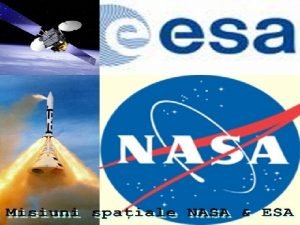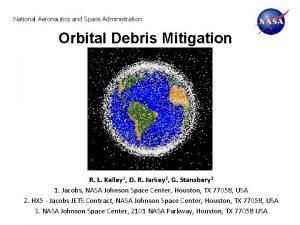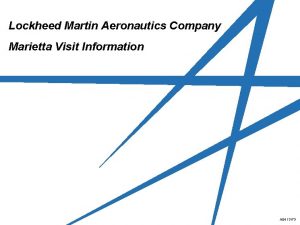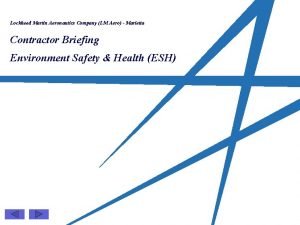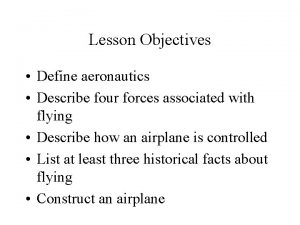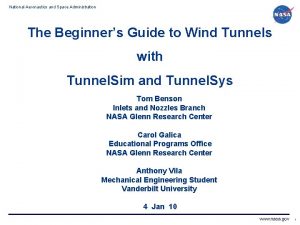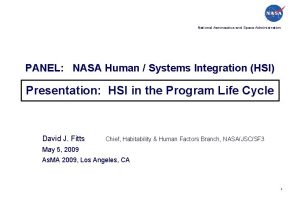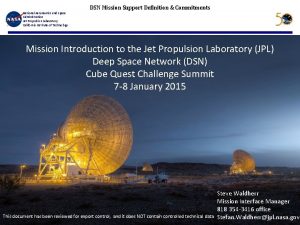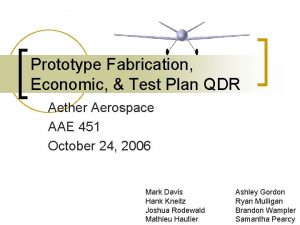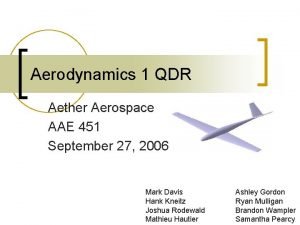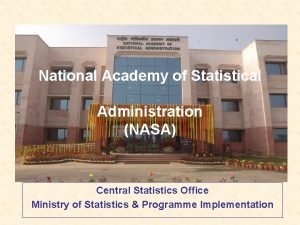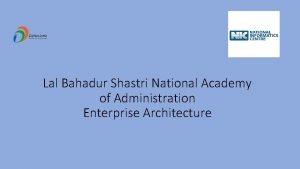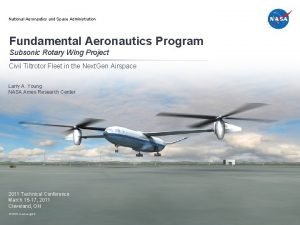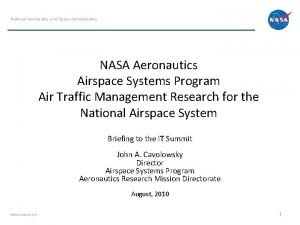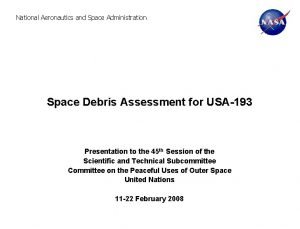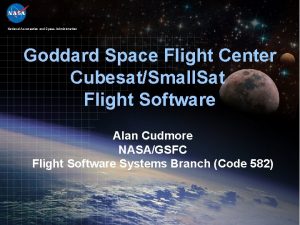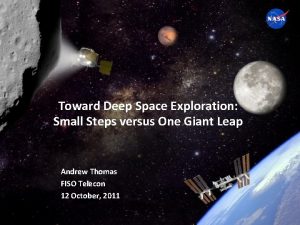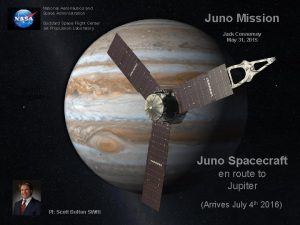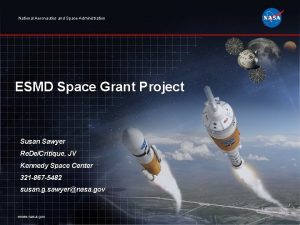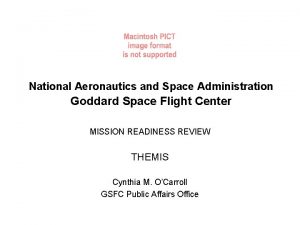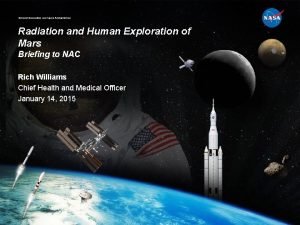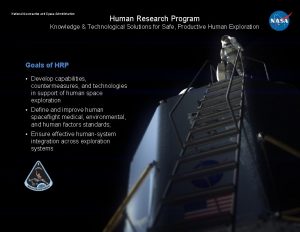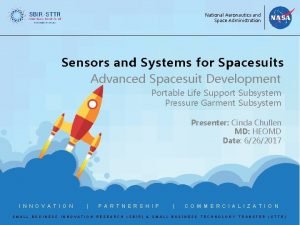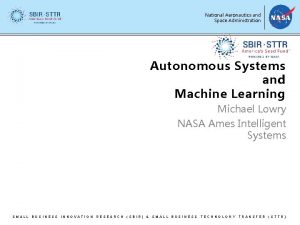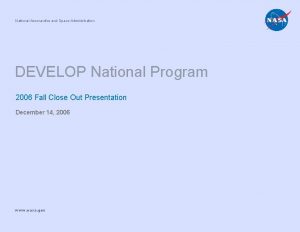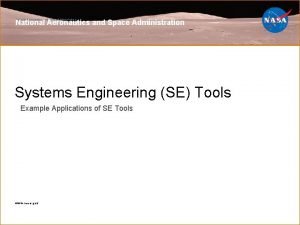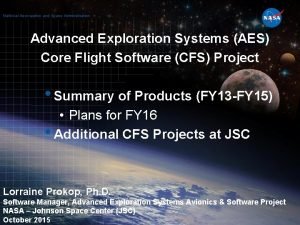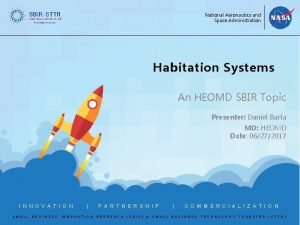National Aeronautics and Space Administration Human Systems Integration






















- Slides: 22

National Aeronautics and Space Administration Human / Systems Integration (HSI) Tools for NASA Systems Engineering David J. Fitts Chief, Habitability & Human Factors Branch, NASA/JSC HSIS 2009 March 18, 2009 1

What is Human/System Integration? HSI Definition in the Do. D HSI = Human/Systems Integration § The interdisciplinary technical and management processes for integrating human considerations within and across all system elements --INCOSE § In the Do. D, HSI has a very specific meaning; Not so in NASA HSI is focused on maximizing Human/System performance in the interest of meeting project design goals and mission objectives § Medical and Behavioral domains may focus more on optimizing human performance § Human Factors, Habitability and Environmental Factors focus more on optimizing the system Since 2000, HSI is a mandate in Do. D Systems Acquisition Requirements § “The Project Manager shall apply HSI to optimize total system performance, operational effectiveness, and suitability, survivability, safety and affordability” The reason HSI is mandated in the Do. D is not to improve man/machine interfaces…it is to save money § To lower costs in the operational era of a program…(80% of the cost of Do. D programs) 2

What is Human/System Integration? HSI Definition in the Do. D (cont’d) In the Do. D, HSI comprises a number of human/system disciplines: § Called “domains” in the Do. D: Domain Intent SLSD Org § Human Factors Engineering -- Optimize system interfaces SF 3 § Habitability -- Living conditions SF 3 § Environmental Factors -- Work conditions SF 2 § Occupational Health -- Reduce risks to health and well-being SD § Countermeasures -- Maintain human performance SK § Survivability -- Reduce risks to life (partially SLSD) § System Safety -- Reduce risk of failure and error § Training -- Optimize operator readiness § Manpower -- Operator numbers & skills § Personnel Capabilities -- Operator physical & cognitive abilities 3

What is Human/System Integration? NASA and HSI There is currently no Agency-wide Human/Systems Integration (HSI) consensus or initiative but there’s awareness and discussion § The term “HSI” is used herein to apply to NASA-equivalents to Do. D HSI domain knowledge At the Johnson Space Center (JSC) the Space Life Sciences Directorate (SLSD) has looked at the Do. D model of HSI for potential application to human spaceflight § SLSD domains currently include Medicine, Environmental Factors, Human Factors, Habitability, Countermeasures, and Survivability (partially) NASA human spaceflight programs reside and are managed at JSC as well as all projects carrying crew § Programs: Space Shuttle, International Space Station (ISS), Constellation (Cx) § Projects: Crew Exploration Vehicle (CEV), Lunar Lander, Lunar Surface Systems, Cx EVA SLSD is currently the prime provider of HSI services and products to NASA human spaceflight programs § But HSI includes organizations beyond JSC/SLSD--i. e. , other Centers, other JSC orgs, etc. 4

HSI in NASA Systems Engineering The NASA Project Life-Cycle: Project Formulation Development Operations The NASA Project life-cycle road-map is similar to Do. D models 5

HSI in NASA Systems Engineering HSI must engage every phase of Development and Operations SLSD Habitability and Human Factors Core Capabilities are designed to align with the Project Life-Cycle Research How can we do better? Vertical Integration = Successful integration of a domain’s capabilities into a Project’s Life-Cycle Operations Lessons learned! Requirements Development Requirements Integration Negotiating project buy-in Verification Design Were requirements met? Hands-on architectural involvement 6

HSI in NASA Systems Engineering Horizontal Integration among HSI domains: Domain Knowledge (Vertical Integration) (Horizontal Integration) Human/Systems Integration § Puts the “Integration” into HSI § Delivers “HSI” as a cohesive product Space Survivability Habitability Medicine Human Factors Environmental Counter. Monitoring Measures § But when viewed as a simplistic cross-cutting activity, no process is evident for performing Horizontal Integration 7

An Approach to Horizontal Integration NASA HSI Experience in an SE Environment This paper proposes that the Core Capabilities provide a means of breaking Horizontal Integration into manageable components Domain Knowledge (Vertical Integration) Space Survivability Habitability Medicine (Horizontal Integration) Human/Systems Integration § Each component has its own constraints and procedures that guide cross-domain integration Human Factors Environmental Counter. Monitoring Measures Reqts Dev Reqts Intgrtn Design Verification Operations Research 8

Requirements Development Readiness of Standards has been critical to NASA HSI successes NASA-STD-3000, Man/Systems Integration Standards (MSIS) --focused on Habitability, Human Factors & Environmental Factors Standards NASA-STD-3000 First released in 1988, the MSIS provides NASA a vetted product in language tailorable to the needs of Programs & Projects Constellation Human-System Integration Requirements (HSIR) Program-Unique Requirements Project Requirements Derived from NASA-STD-3000 • for International Space Station − SSP 50005, Flight Crew Integration Reqts • for Constellation Programs − Cx. P 70024, Cx. P Human Systems Integration Requirements (HSIR) Deliverables 9

Requirements Development In NASA, Requirements are the principal means by which a procuring organization relates its intentions, needs and expectations § Requirements--including HSI--become a binding part of procurement contracts that must be met unless formally waived Requirements become the foundation for ongoing HSI engagement § Otherwise it would be difficult to justify or sustain the other Core Capabilities Programs/Projects provide processes for establishing consistency across Requirements § These drive commonality across HSI domain inputs § Requirements must be objective, valid, measurable and verifiable § Typically, a requirement must be accompanied by a Verification Statement and Rationale In the SLSD, a series of internal reviews, panels and boards provide social integration tools by which HSI requirements are vetted into a comprehensive suite 10

Requirements Development Example topics in NASA’s Habitability & Environmental Factors Standards • • • Human Performance Capabilities Natural and Induced Environments Anthropometry, Biomechanics and Strength User Interfaces Hardware and Equipment Architecture Maintainability Facility Management Health Management Extravehicular Activity (EVA) 11

Requirements Integration = any process with the goal of ensuring that Requirements are understood and flow to all levels of development § Processes for doing this may vary among domains but the goal is the same--i. e. , reduce the risk of an unsuccessful HSI implementation during Design through Verification Requirements Integration is typically accomplished by teams of subject matter experts with Program/Project sensibility § I. e. , dedicated to their discipline but sensitive to schedules, budgets, production issues, etc. Example domain: Human Factors Engineering (HFE) performs Programrecognized Requirements Integration in the ISS and Cx Programs § HFE is accepted as a system in the Program’s System Engineering & Integration orgs § HFE Leads are Program/Project supported System Managers Social integration tools again play an important role in integrating common “HSI” positions and resolving differences into a unified whole § In NASA/SLSD, the position is currently titled “Health & Medical Technical Authority” 12

Requirements Integration Example Program-recognized SLSD “HSI” roles in spaceflight projects § Constellation Program (Cx. P): − Cx. P Health and Medical Technical Authority Lead − Human Systems Integration Group Lead § Cx. P Crew Exploration Vehicle (CEV) Project: − Human Systems Integration Lead − Human Engineering Subsystem Manager − Crew Cockpit Working Group HFE Lead § Cx. P Lunar Lander & Lunar Surface Systems (LSS) Project: − Habitability (and conceptual design and development) Lead § Cx. P Extra-Vehicular Activity (EVA) Project: − Human Systems Integration Lead § International Space Station (ISS) Program: − ISSP Health and Medical Technical Authority Lead − Flight Crew Integration [HFE] System Manager − Food System Manager § Human Research Program (HRP): − − Space Human Factors & Habitability Element Manager Space Human Factors & Habitability Element Scientist Space Human Factors Engineering Project Lead Advanced Food Technology Project Lead 13

Design “Design” is used here to describe direct participation of HSI domains in Project Design and development § When participation goes beyond describing intent by Requirements alone. . . § Requires domains to develop the capabilities needed to participate in design! § Not all Design issues can be foreseen during Requirements Development Example domain: SLSD’s Habitability Design Center (HDC) has engaged in several effective collaborations with Engineering design teams § Most recently the HDC designed, evaluated and outfitted the interior crew quarters of the Lunar Electric Rover (LER). The LER provided the closing event in President Obama’s Inauguration Parade § HDC has supported projects for ISS, CEV, Lunar Lander, Lunar Surface Systems, & others Experience: Projects with a strong sense of design value this kind of active HSI participation § HSI Designers are particularly useful where iterative early concept design and evaluation are planned § HSI Design must include human user evaluation--by model or human test--to inform Development phase decisions with objective Operations era impact data 14

Design HDC example activity: • Graphic prototyping: • Physical prototyping: 15

Design HDC example activity: (cont’d) • User Evaluations: 16

Design can be a unifying Horizontal Integration force when evaluations of design options are comprehensive and inclusive across HSI disciplines § It is important to understand the Operational impact of Development decisions to many human-centered perspectives—e. g. , behavior, physical fit, cognitive workload, etc. § NASA SLSD has forward work to increase the number, scope, and efficiency of integrated human/system evaluations 17

Verification, ultimately, is formal acceptance that Requirements have been satisfied prior to product delivery § In practice Verification is a continuum of processes that reduce risk of Requirements failure § Requirements Integration teams maintain vigilance during Development Verification begins during Requirements Development § NASA Requirements are typically accompanied by Verification Statements defining expectations for techniques needed for adequate Requirements compliance Requirements Integration teams maintain vigilance during Development § Not all Development problems can be foreseen when Requirements are first written Verification processes are usually formal Program-managed processes § Like Requirements Development, consistent Program control is essential to contract integrity § Program formal processes drive consistent HSI domain Horizontal Integration § Like Design evaluation, opportunities are rife for developing efficient, multi-domain Verification techniques 18

Operations are the ultimate proving ground for the validity of the Requirements through Verification efforts § HSI concerns often don’t manifest themselves until human and system interact in the field § Ideally, products are delivered out of Development that are easy to use, prevent human errors, minimize training, and require little maintenance Operations success and efficiency should have been major design drivers throughout Development § HSI products such as a ‘Concept of Operations’ should have been required organizing tools since Project Formulation § However, Development & Operations project phases are often managed by different teams Operations monitoring evaluates the success of Development phase HSI § Without this activity, lessons learned for improving domain performance are never identified Ultimately, better HSI techniques must be developed for informing Development decisions with objective Operations metrics § Predictive tools are needed for early evaluation of Design concepts § HSI domains must work together to “reverse engineer” such tools 19

Research allows disciplines to identify and fill gaps in knowledge, skills, practices, or processes exposed during Development/Operations § Research enables a discipline’s “long view”; It provides recovery time to invest in the field’s knowledge base To complete the Six Capabilities cycle, Research must be Directed—i. e. , with results specifically targeted at filling a knowledge gap § “Directed Research” as opposed to “Pure Research” The current NASA environment is favorable toward Directed Research § The Human Research Program (HRP) emphasizes producing results that benefit current spaceflight Programs or Projects § Elements of HRP are currently helping solve Cx Program Design and Operations issues HRP Directed Research is allowing SLSD domains to address crossintegration capability gaps § HRP invests in the exploration of NASA “HSI” and in needed integration capabilities 20

Review & Summation An Approach to HSI Horizontal Integration This paper proposes that Six Core Capabilities provide a means of breaking Horizontal Integration into manageable component pieces Domain Knowledge (Vertical Integration) (Horizontal Integration) Human/Systems Integration § Each “row” has its own constraints and procedures that can steer cross-domain integration § Each row’s integration opportunities and challenges are worth a paper Space Survivability. Habitability Human Environmental. Counter. Medicine Factors Monitoring Measures Reqts Dev Reqts Intgrtn Design Verification Operations Research 21

Review & Summation Requirements Integration & Verification are generally tightly controlled by Program processes § These processes integrate beyond HSI, inclusive of hardware, software and human systems § Processes are typically managed by Program Offices themselves HSI organizations must develop their own cross-domain integration techniques for the other four capabilities HSI organizations must particularly develop their own Design and Research capabilities and integrate them into a comprehensive plan § Programs are least likely to provide funding or guidance for Design or Research § However, Design capabilities are essential to a fully engaged HSI program; Directed Research recovery time is essential to HSI strategic deployment and growth Programs won’t necessarily perform or enable HSI Horizontal Integration; it is up to HSI organizations to develop the skills and techniques § Techniques herein aren’t yet codified in NASA, but they’re essentially in use or in work 22
 National aeronautics and space administration
National aeronautics and space administration National aeronautics and space administration, u.s.a.
National aeronautics and space administration, u.s.a. Mit aeronautics and astronautics
Mit aeronautics and astronautics Department of aeronautics and astronautics
Department of aeronautics and astronautics What was the first tool of aeronautics to be developed?
What was the first tool of aeronautics to be developed? Canoe restaurant
Canoe restaurant Tdot aeronautics
Tdot aeronautics Lm aeronautics
Lm aeronautics Define:aeronautics
Define:aeronautics Beginner's guide to aeronautics
Beginner's guide to aeronautics Hsi
Hsi Aeronautics definition
Aeronautics definition Part of hot air balloon
Part of hot air balloon Aether aeronautics
Aether aeronautics Maximum lift coefficient formula
Maximum lift coefficient formula Forward integration and backward integration
Forward integration and backward integration Make or buy continuum
Make or buy continuum Simultaneous integration and sequential integration
Simultaneous integration and sequential integration National academy for public administration
National academy for public administration National academy of statistical administration
National academy of statistical administration National highway safety administration reviews
National highway safety administration reviews Miramar national cemetery grave locator
Miramar national cemetery grave locator Lbsnaa mess menu
Lbsnaa mess menu
